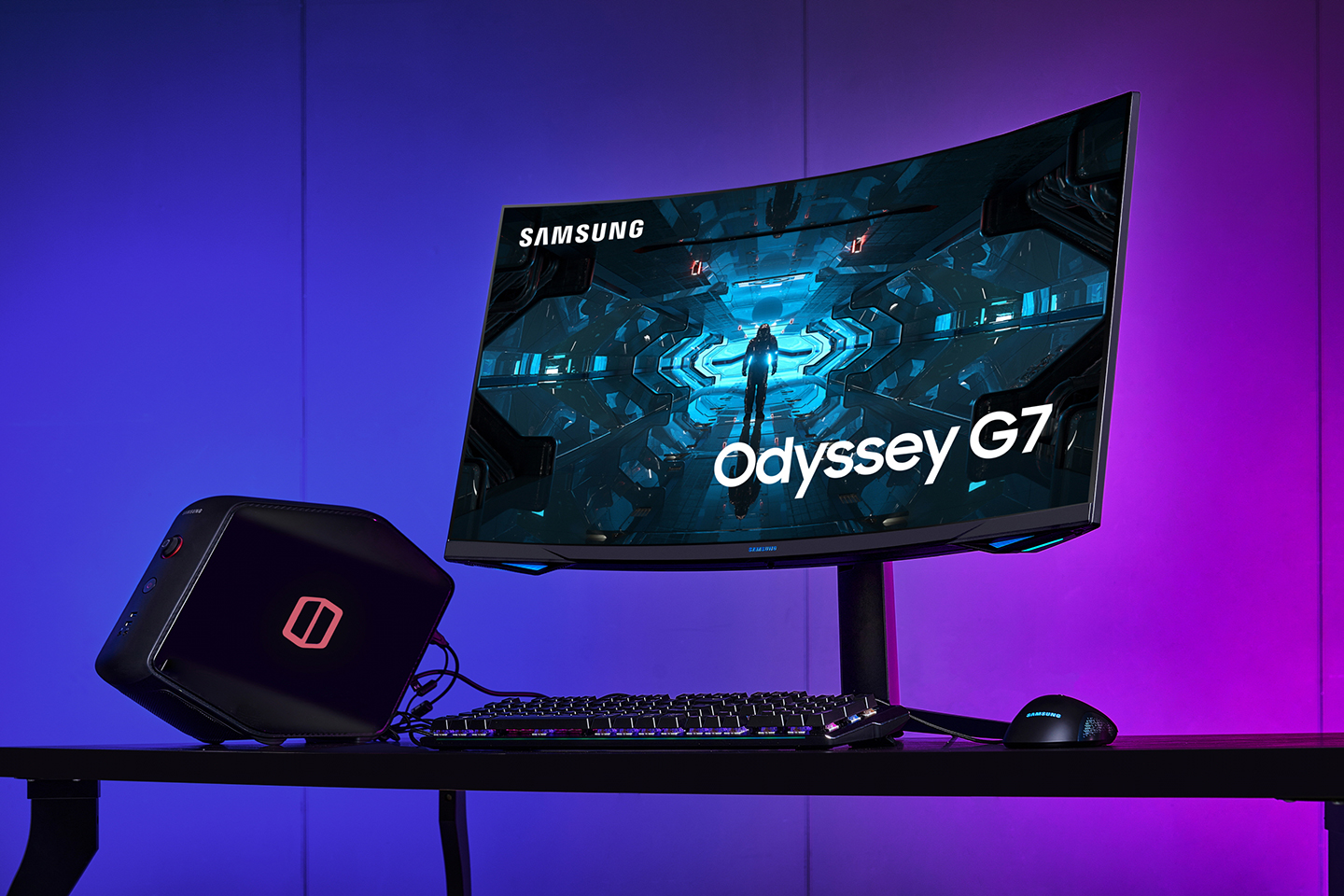Samsung Launches Aggressively-Curved Odyssey G7 Gaming Monitor
A 1000R curve
Back at CES Samsung showed off its new super-curved Odyssey gaming monitors, but half a year has gone by since and it's been awfully quiet from the manufacturer. Today, that changes with the introduction of the Odyssey G7, outed in 27-inch and 32-inch flavors.
The Odyssey G7 comes with a 1000R curvature, which means the center point of its radius is at 1000 mm, or about 3 feet away. That might not sound like much, but it's extremely tight for a monitor and a world-first.
Samsung packed the display with a QHD (2560x1440) QLED panels, which essentially entails that an LED array resides behind the panel for HDR support. The monitors are capable of a typical brightness of 350 nits, but can peak up to 600 nits in localized bright spots and are therefore HDR 600 certified.

The monitors are also incredibly fast, offering refresh rates of up to 240 Hz with 1 ms response times, and support both Nvidia G-Sync as well as FreeSync Premium Pro.
Of course, we're even more excited about the Odyssey G9, which will bring similar specs to the table but in a 32:9 form factor with a huge, 5120 x 1440 resolution. No word on when that display will be released.
Samsung is still quiet on pricing for the Odyssey G7 27-inch and 32-inch. Don't expect them to come cheap though -- these specs will cost you, but if you have the cash, they'll probably be some of the best gaming monitors money can buy.
Get Tom's Hardware's best news and in-depth reviews, straight to your inbox.
Niels Broekhuijsen is a Contributing Writer for Tom's Hardware US. He reviews cases, water cooling and pc builds.
-
JamesSneed ReplyZizo007 said:IPS? No 4K?
Weird that you didn't read the article. They are VA panels. Yes 4K+( 5120 x 1440 ) later when the Odyssey G 9 comes out. -
remy721 Actually, the answer is No, No, and No, No (again).Reply
It's not an IPS or VA panel, it's a QLED panel, which is like an LED panel (TN) with "Quantum Dot" technology -- basically, a standard backlit LCD panel with a special layer between that allows the pixels to be blocked out completely, allowing for "true" black.
It's also not 4K -- the one the article is about is actually QHD (2560 x 1440) and the G9 is an extreme-wide QHD (basically, two QHD monitors side-by-side). Neither is 4K or "4K+". -
cryoburner Reply
According to the prior article linked within this one, these are using VA panels with a quantum dot filter, not TN. The "LED" part of "QLED" is just referring to them using an LED backlight, which are used by all modern IPS, VA and TN panels, all of which are variations of LCD panels. Likely, Samsung just picked the QLED name to be more marketable against OLED in the television space. OLED is a completely different technology though, with each pixel being its own light source.remy721 said:It's not an IPS or VA panel, it's a QLED panel, which is like an LED panel (TN) with "Quantum Dot" technology -- basically, a standard backlit LCD panel with a special layer between that allows the pixels to be blocked out completely, allowing for "true" black.
4K is not exactly ideal for today's gaming screens, as pushing frame rates much above 60fps is a challenge for even today's highest-end graphics cards at that resolution. And even if the next generation of graphics cards improve on that, it will be quickly countered by games becoming more demanding as they target the next generation of console hardware.Zizo007 said:No 4K?
So for high-end gaming, high refresh-rate 1440p screens are generally considering a better option at this time. That super-ultrawide 32:9 screen is actually pretty close to 4K though. At 5120 x 1440, it offers more horizontal pixels than 4K, but fewer vertical pixels, and ends up only around 11% short of the total pixels at 4K. -
bit_user Hmm... I hope the price isn't too dear. I've had my eye on the 27", since it was announced. It ticks all the boxes, except I really wasn't looking for such aggressive curvature. I could overlook that, if everything else is good.Reply -
bit_user Reply
Most curved monitors seem to be VA. Samsung is big on VA, especially toward the upper end of their range. IPS still cannot match the static contrast ratio.Zizo007 said:IPS? No 4K?
And 4k at 240 Hz? Um... no.
I don't see anywhere in the article that actually says they're VA.JamesSneed said:Weird that you didn't read the article.
Um, how do you get 4k from that? 4k seems most commonly used to mean 3840x2160. It's referring to the horizontal resolution being nearly 4000 pixels across. Crappy name, but using it to mean 5k x 1.4k seems a stretch too far. They don't even have the same number of pixels (3840x2160 has 12.5% more)!JamesSneed said:Yes 4K+( 5120 x 1440 ) later when the Odyssey G 9 comes out.
Regarding the OP's question about 4k, I took it as maybe expressing a question about whether there might be any 4k models in the pipeline, or otherwise remarking at the absense of a 4k model - neither of which are addressed by the article.
If you're going to rebuke people, you might want to just take a second and make sure that you're not even further off the mark than they are. -
bit_user Reply
There are some GSync Ultimate monitors on here:docbones69 said:argh - where are the 4k 600 hdr monitors.
https://www.nvidia.com/en-us/geforce/products/g-sync-monitors/specs/ -
bit_user Update: The 27" and 32" are both listed here:Reply
https://www.amazon.com/dp/B088HJ4VQK/ref=twister_B08B8HVKRN
Release date: July 14th.
The official specs on the 27" are here:
https://www.samsung.com/us/computing/monitors/gaming/27--odyssey-g7-gaming-monitor-lc27g75tqsnxza/
It's mostly the same info as on the Amazon listing, with one important addition...
Inputs: One HDMI and two DP 1.4 inputs. The version of the HDMI isn't specified, nor is whether DP supports HBR3.
